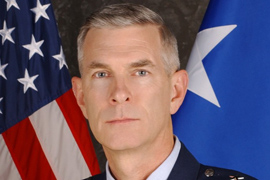Maj. Gen. Robert A. Knauff, Former New York Air National Guard Commander with Ties to U.S. Antarctic Science, Dies in Glider CrashCommanded during a critical period in the NSF-managed U.S. Antarctic Program  Maj. Gen. Robert A. Knauff Maj. Gen. Robert A. Knauff, the former commander of the New York Air National Guard, was killed early this month in a glider accident in Aquila, Arizona. A funeral service and burial were held this week in New York State.
Knauff commanded the 6,000-member New York Air National Guard and served as deputy commander of the 17,000 men and women of the New
York Army and Air National Guard. Upon his retirement from military service in February 2009 the National Science Foundation (NSF)
"General Knauff was a great supporter of science, and his effective leadership was a key factor in keeping the mission moving forward," said Dr. Kelly Falkner, the Director of the NSF-managed United States Antarctic Program (USAP). "Bob was a great member of our team, and continued to remain an advocate for the program even into his retirement. We are all deeply saddened by his untimely loss, but the legacy of his achievement lives on through the accomplishments he made possible in Antarctica."
Knauff played a key role in the USAP during a critical period of expansion and intense need for logistical support.
The 109th Airlift Wing of the New York Air National Guard provides logistical support to the USAP and to the science supported by NSF's Division of Polar Programs in Greenland. Through the USAP, NSF coordinates all U.S. research on the southernmost continent and provides all of the logistical support for the science. Ski-equipped LC-130 aircraft from the New York Air National Guard are a vital component of that logistical support, providing transportation for personnel and cargo to the continent from New Zealand and ferrying personnel and supplies to Amundsen-Scott South Pole Station, in the interior of the continent, as well as deep-field research sites. Knauff played a key role in the USAP during a critical period of expansion and intense need for logistical support. New York Air National Guard LC-130 flights were instrumental in the successful completion of the new South Pole station, which was dedicated in 2008. Each component of the station was designed to fit into the cargo hold of the ski-equipped aircraft; the only planes with the necessary heavy lift capability to be able to land at the Pole. The Guard also transported all of the personnel and equipment needed to complete two large-scale scientific projects at the Pole; the 10-meter South Pole Telescope and the IceCube Neutrino Observatory. A 1975 graduate of the U.S. Air Force Academy, Knauff completed undergraduate pilot training in 1976. In the years following, he undertook a series of flying and command assignments culminating with his duty at the New York State Division of Military and Naval Affairs in Latham, NY. In addition, he served as the Air National Guard assistant to the commander, U.S. Air Force Special Operations Command. He was a combat veteran with more than 3,900 flying hours n F-106 Delta Daggers, F-15 Eagle, F-16 Falcon and OV-10 observation aircraft. He commanded the 174th Fighter Wing at Hancock field from 1996 to 2003, prior to becoming Chief of Staff of the Air National Guard and then Commander. |



For USAP Participants |
For The Public |
For Researchers and EducatorsContact UsNational Science FoundationOffice of Polar Programs Geosciences Directorate 2415 Eisenhower Avenue, Suite W7100 Alexandria, VA 22314 Sign up for the NSF Office of Polar Programs newsletter and events. Feedback Form |

